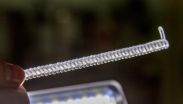(Press-News.org) University of Colorado Boulder scientists have found a creative way to radically improve thermoelectric materials, a finding that could one day lead to the development of improved solar panels, more energy-efficient cooling equipment, and even the creation of new devices that could turn the vast amounts of heat wasted at power plants into more electricity.
The technique—building an array of tiny pillars on top of a sheet of thermoelectric material—represents an entirely new way of attacking a century-old problem, said Mahmoud Hussein, an assistant professor of aerospace engineering sciences who pioneered the discovery.
The thermoelectric effect, first discovered in the 1800s, refers to the ability to generate an electric current from a temperature difference between one side of a material and the other. Conversely, applying an electric voltage to a thermoelectric material can cause one side of the material to heat up while the other stays cool, or, alternatively, one side to cool down while the other stays hot.
Devices that incorporate thermoelectric materials have been used in both ways: to create electricity from a heat source, such as the sun, for example, or to cool precision instruments by consuming electricity.
However, the widespread use of thermoelectric materials has been hindered by a fundamental problem that has kept scientists busy for decades. Materials that allow electricity to flow through them also allow heat to flow through them. This means that at the same time a temperature difference creates an electric potential, the temperature difference itself begins to dissipate, weakening the current it created.
Until the 1990s, scientists addressed this problem by looking for materials with intrinsic properties that allowed electricity to flow more easily than heat.
"Until 20 years ago, people were looking at the chemistry of the materials," Hussein said. "And then nanotechnology came into the picture and allowed researchers to engineer the materials for the properties they wanted."
Using nanotechnology, material physicists began creating barriers in thermoelectric materials—such as holes or particles—that impeded the flow of heat more than the flow of electricity. But even under the best scenario, the flow of electrons—which carry electric energy—also was slowed.
In a new study published in the journal Physical Review Letters, Hussein and doctoral student Bruce Davis demonstrate that nanotechnology could be used in an entirely different way to slow the heat transfer without affecting the motion of electrons.
The new concept involves building an array of nanoscale pillars on top of a sheet of a thermoelectric material, such as silicon, to form what the authors call a "nanophononic metamaterial." Heat is carried through the material as a series of vibrations, known as phonons. The atoms making up the miniature pillars also vibrate at a variety of frequencies. Davis and Hussein used a computer model to show that the vibrations of the pillars would interact with the vibrations of the phonons, slowing down the flow of heat. The pillar vibrations are not expected to affect the electric current.
The team estimates that their nanoscale pillars could reduce the heat flow through a material by half, but the reduction could be significantly stronger because the calculations were made very conservatively, Hussein said.
"If we can improve thermoelectric energy conversion significantly, there will be all kinds of important practical applications," Hussein said. These include recapturing the waste heat emitted by different types of equipment—from laptops to cars to power plants—and turning that heat into electricity. Better thermoelectrics also could vastly improve the efficiency of solar panels and refrigeration devices.
The next step is for Hussein to partner with colleagues in the physics department and other institutions to fabricate the pillars so that the idea can be tested in the lab. "This is still early in the phase of laboratory demonstration but the remaining steps are within reach."
Hussein also hopes to further refine the models he used to gain additional insight into the underlying physics. "A team of highly motivated Ph.D. students are working with me around the clock on this project," he said.
INFORMATION:
The research was funded by the National Science Foundation.
Read the study at http://prl.aps.org/abstract/PRL/v112/i5/e055505.
Nanoscale pillars could radically improve conversion of heat to electricity
2014-02-20
ELSE PRESS RELEASES FROM THIS DATE:
Developing countries face 'leading medical scourge of developed countries'
2014-02-20
(Garrison, NY) Chronic illness, already a major and expensive problem in developed countries, is rapidly increasing in developing countries, adding to the longstanding burden caused by high rates of infectious diseases. However, poor countries will not be able to afford the costly medical technologies that wealthy countries use to treat chronic conditions, including heart disease, stroke, cancer, pulmonary disease, and diabetes, writes Daniel Callahan, cofounder of The Hastings Center.
Callahan examines this trend and concludes that it calls for a new, more economically ...
Long-term daily multivitamin supplement use decreases cataract risk in men
2014-02-20
SAN FRANCISCO – Feb. 20, 2014 – Long-term daily multivitamin supplement use may lower cataract risk in men, according to a study of nearly 15,000 male physicians published this month in Ophthalmology, the journal of the American Academy of Ophthalmology.
Past observational studies have indicated a relationship between nutritional supplement use and eye health. However, randomized trial data on the effects of long-term multivitamin supplement use and risk of eye diseases are limited and, in some cases, non-existent. To address this, researchers based at Brigham and Women's ...
Extreme weather decides distribution of insects
2014-02-20
As climate change is progressing, the temperature of our planet increases. This is particularly important for the large group of animals that are cold-blooded (ectothermic), including insects. Their body temperature is ultimately determined by the ambient temperature, and the same therefore applies to the speed and efficiency of their vital biological processes.
But is it changes in average temperature or frequency of extreme temperature conditions that have the greatest impact on species distribution? This was the questions that a group of Danish and Australian researchers ...
UT Dallas-led team makes powerful muscles from fishing line and sewing thread
2014-02-20
An international team led by The University of Texas at Dallas has discovered that ordinary fishing line and sewing thread can be cheaply converted to powerful artificial muscles.
The new muscles can lift a hundred times more weight and generate a hundred times higher mechanical power than the same length and weight of human muscle. Per weight, they can generate 7.1 horsepower per kilogram, about the same mechanical power as a jet engine.
In a paper published Feb. 21 in the journal Science, researchers explain that the powerful muscles are produced by twisting and ...
Bioengineered growth factors lead to better wound healing
2014-02-20
When we are wounded, our bodies naturally begin a process of repair of the damaged tissue. This process is mediated by biological molecules called growth factors, which are proteins that occur naturally in our cells and guide processes ranging from embryonic development to healing. Given their regenerative role in the body, growth factors have been investigated for use in drugs but with limited success. Publishing in Science, an EPFL group has used bioengineering to significantly improve the efficacy of clinical growth factors in the context of soft tissue and bone repair, ...
Previous rapid thinning of Pine Island Glacier sheds light on future Antarctic ice loss
2014-02-20
New research, published this week in Science, suggests that the largest single contributor to global sea level rise, a glacier of the West Antarctic Ice Sheet, may continue thinning for decades to come. Geologists from the UK, USA and Germany found that Pine Island Glacier (PIG), which is rapidly accelerating, thinning and retreating, has thinned rapidly before. The team say their findings demonstrate the potential for current ice loss to continue for several decades yet.
Their findings reveal that 8000 years ago the glacier thinned as fast as it has in recent decades, ...
Scientists create powerful artificial muscle with fishing line
2014-02-20
Researchers are using fibres from fishing line and sewing thread to create inexpensive artificial muscles that could be used in medical devices, humanoid robots, prosthetic limbs, or woven into fabrics.
In a study published today in Science, international researchers, including University of British Columbia Electrical and Computer Engineering professor John Madden and PhD candidate Seyed Mohammad Mirvakili, detail how they created inexpensive artificial muscles that generate far more force and power than human or animal muscles of the same size.
"In terms of the strength ...
Unstable Atlantic deep ocean circulation under future climate conditions
2014-02-20
Today, deep waters formed in the northern North Atlantic fill approximately half of the deep ocean globally. In the process, this impacts on the circum-Atlantic climate, regional sea level, and soak up much of the excess atmospheric carbon dioxide from industrialisation — helping to moderate the effects of global warming. Changes in this circulation mode are considered a potential tipping point in future climate change that could have widespread and long-lasting impacts including on regional sea level, the intensity and pacing of Sahel droughts, and the pattern and rate ...
Sequencing hundreds of nuclear genes in the sunflower family now possible
2014-02-20
Advances in DNA sequencing technologies have enormous potential for the plant sciences. With genome-scale data sets obtained from these new technologies, researchers are able to greatly improve our understanding of evolutionary relationships, which are key to applications including plant breeding and physiology.
Studies of evolutionary (or phylogenetic) relationships among different plant species have traditionally relied on analyses of a limited number of genes, mostly from the chloroplast genome. Such studies often fail to fully or accurately resolve phylogenetic ...
Study shows that premature infants benefit from adult talk
2014-02-20
Research led by a team at Women & Infants Hospital of Rhode Island and The Warren Alpert Medical School of Brown University has been published in the February 10, 2014 online edition of Pediatrics, the official journal of the American Academy of Pediatrics. The research indicates that premature babies benefit from being exposed to adult talk as early as possible.
The research, entitled "Adult Talk in the NICU (neonatal intensive care unit) with Preterm Infants and Developmental Outcomes," was led by Betty Vohr, MD, director of Women & Infants' Neonatal Follow-Up Program ...




